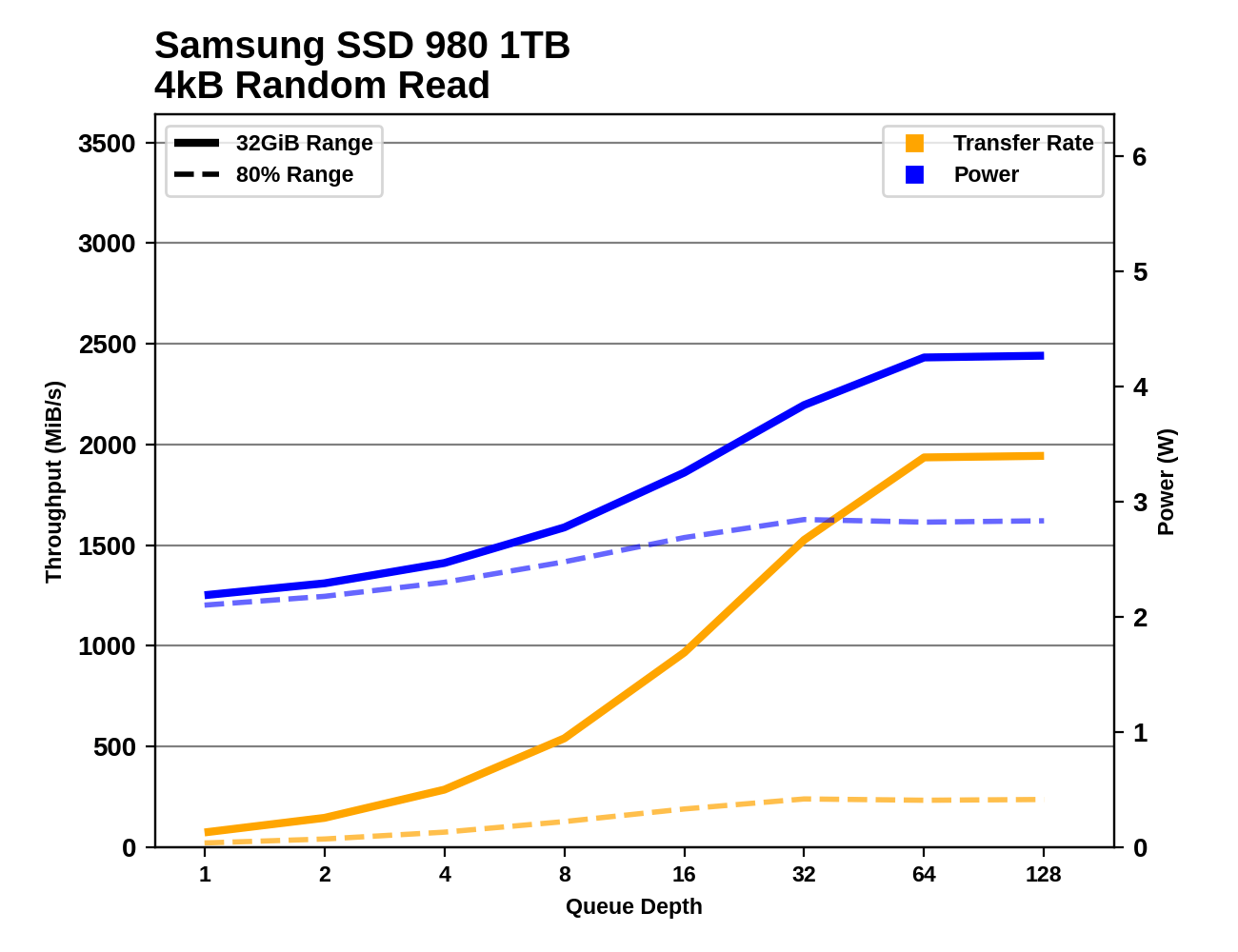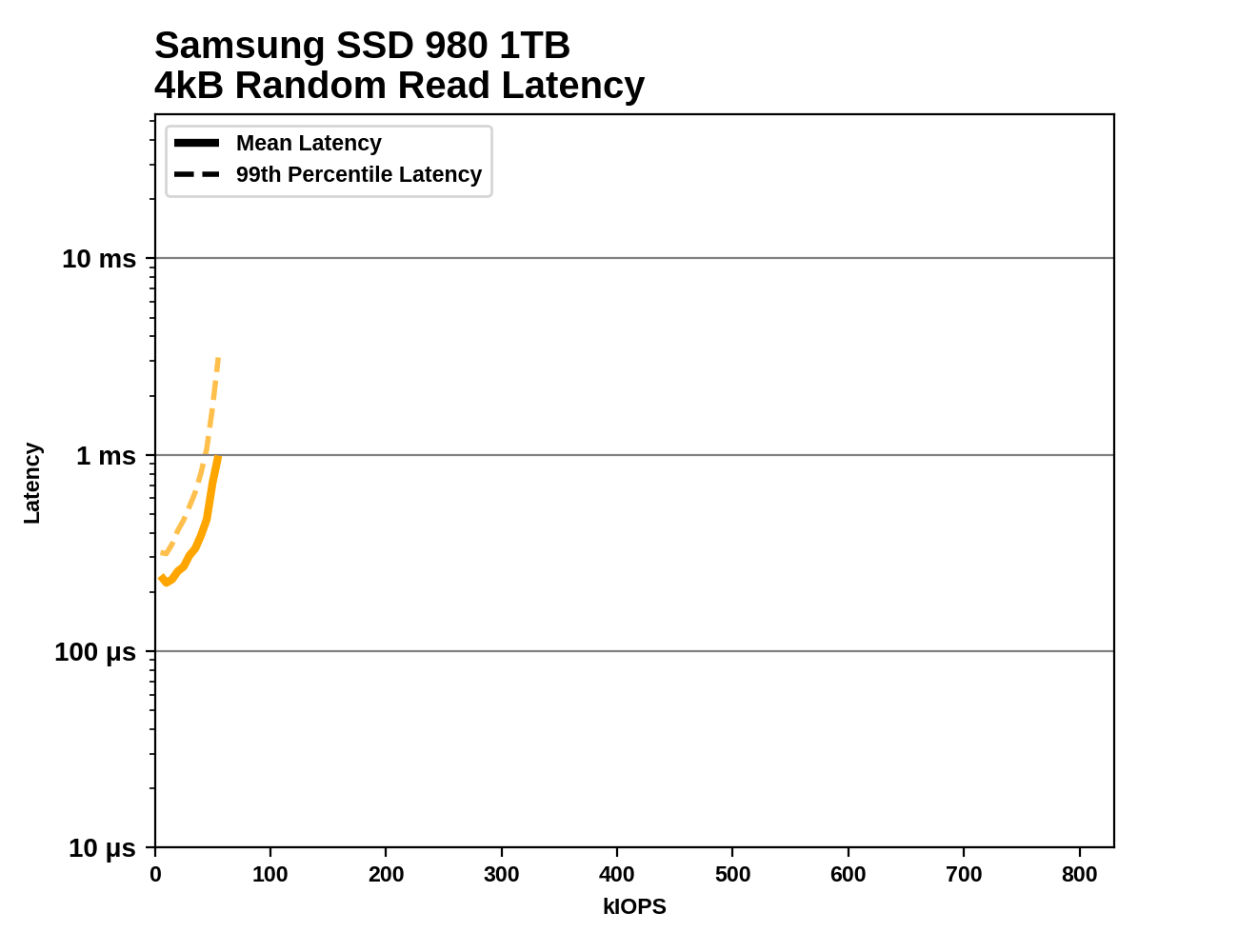The Samsung SSD 980 (500GB & 1TB) Review: Samsung's Entry NVMe
by Billy Tallis on March 9, 2021 10:00 AM ESTBurst IO Performance
Our burst IO tests operate at queue depth 1 and perform several short data transfers interspersed with idle time. The random read and write tests consist of 32 bursts of up to 64MB each. The sequential read and write tests use eight bursts of up to 128MB each. For more details, please see the overview of our 2021 Consumer SSD Benchmark Suite.
 |
|||||||||
| Random Read | Random Write | ||||||||
| Sequential Read | Sequential Write | ||||||||
Given that the Samsung SSD 980 is a DRAMless drive with aggressive SLC caching, it's no surprise to see that most of the burst IO scores show a big difference between testing a small slice of a mostly-empty drive and testing across an 80% full drive. The test runs with the NVMe Host Memory Buffer feature disabled also show how important that is to enabling random IO performance. In the best cases, the SSD 980 even manages to deliver better QD1 random read performance than the 980 PRO. However, when testing against a large data set (or with HMB disabled), the SSD 980's performance only remains competitive for sequential reads. For the other IO patterns, its performance drops far more than typical for entry-level drives.
Sustained IO Performance
Our sustained IO tests exercise a range of queue depths and transfer more data than the burst IO tests, but still have limits to keep the duration somewhat realistic. The primary scores we report are focused on the low queue depths that make up the bulk of consumer storage workloads. For more details, please see the overview of our 2021 Consumer SSD Benchmark Suite.
 |
|||||||||
| Random Read | Throughput | Power | Efficiency | ||||||
| Random Write | Throughput | Power | Efficiency | ||||||
| Sequential Read | Throughput | Power | Efficiency | ||||||
| Sequential Write | Throughput | Power | Efficiency | ||||||
When testing under favorable conditions with a small data set, the SSD 980's performance is at the very least competitive with other entry-level NVMe SSDs and sometimes against mainstream drives as well, but it falls apart too easily. Performance on the sustained IO tests shows similar behavior to the burst IO tests with generally quite large performance drops on the SSD 980 when testing is not constrained to a small data set. Bringing in some moderately higher queue depths has helped the sequential write performance catch up somewhat when testing against an 80% full drive.
 |
|||||||||
| Random Read | |||||||||
| Random Write | |||||||||
| Sequential Read | |||||||||
| Sequential Write | |||||||||
When running the sustained IO tests against a 32GB range of the drives, the Samsung SSD 980 shows good performance scaling with increasing queue depths and can eventually achieve quite high throughput. Random reads take a long time to reach full speed at QD64, while random writes and sequential reads saturate around QD8 and sequential writes saturate at QD2. But testing on a wide range of a mostly-full drive reveals lots of problems: random reads and writes are very slow even at extreme queue depths, and the sequential write test frequently overruns the SLC cache.
Random Read Latency
This test illustrates how drives with higher throughput don't always offer better IO latency and Quality of Service (QoS), and that latency often gets much worse when a drive is pushed to its limits. This test is more intense than real-world consumer workloads and the results can be a bit noisy, but large differences that show up clearly on a log scale plot are meaningful. For more details, please see the overview of our 2021 Consumer SSD Benchmark Suite.
 |
|||||||||
This random read latency test paints a pretty bleak picture for the Samsung SSD 980: every other drive in this bunch has lower latency and higher throughput, and the 500GB 980 actually does slightly better than the 1TB. This test is covering 80% of the drive so HMB is no help here, but that applies to the other DRAMless NVMe drives as well.










54 Comments
View All Comments
XacTactX - Wednesday, March 10, 2021 - link
Honestly I agree with you, the Hynix P31 is a top tier SSD and it costs $135 instead of $130 for this. A reasonable person should pay $5 extra. I also think the Phison E12 would be a nice alternative for ~$110, if only the manufacturers of all the E12 products would stop changing the flash memory and the controller every few months. I don't have faith in Adata, and I have only a little bit more confidence in Silicon Powerdsplover - Wednesday, March 10, 2021 - link
Right now “new” PCI 3.0 units are probably NOS. They’re all fast enough. This summer PCI 3 x 4 NVMe manufacturing will be competing to empty out old parts. Should be a great time for 2TB models for 149 USD.Billy Tallis - Thursday, March 11, 2021 - link
I really doubt Phison has stopped making new E12 controllers yet. They're still far too popular. Even E16 is still thriving as the cheaper gen4 option than E18 for use with QLC, and there are even some E16s going into gen3-only drives. Silicon Motion obviously can't stop manufacturing for the SM2262(EN) family until well after their new 8-channel controllers are shipping in volume; but they haven't hit the market yet.So I'd say it'll probably be at least another two years before a significant fraction of gen3 drives on the retail market are new-old-stock. These products aren't going away yet, and won't go away overnight.
mulamboi - Wednesday, April 21, 2021 - link
Does anyone already know how much samsung 980 pro 1tb to undermine 1 chia?Brazilian here o /